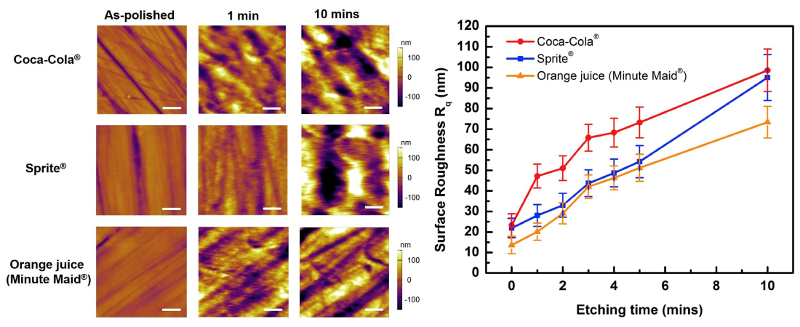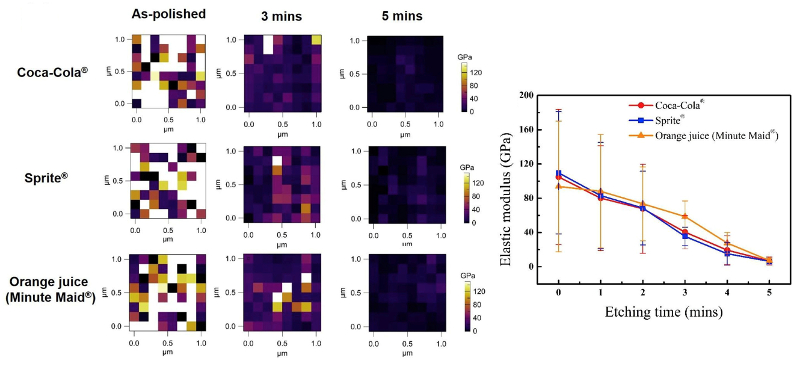AFM Systems
AFM Accessories
Learning
Contact Us
 Part of the Oxford Instruments Group
Part of the Oxford Instruments Group
Korean reseachers used AFM techniques to quantitatively assess the earliest stages of tooth enamel erosion from sugary, acidic drinks. They found that surface roughness increased and elastic modulus decreased with increasing immersion time in the beverages.
 Tooth enamel acts as a hard, damage-resistant barrier to protect the tooth’s soft inner layers. However, overexposure to sugary and acidic beverages can degrade the enamel and lead to a variety of dental health issues. More information about enamel erosion processes, especially their initial stages, is needed to prevent and treat these conditions.
Tooth enamel acts as a hard, damage-resistant barrier to protect the tooth’s soft inner layers. However, overexposure to sugary and acidic beverages can degrade the enamel and lead to a variety of dental health issues. More information about enamel erosion processes, especially their initial stages, is needed to prevent and treat these conditions.
Researchers at the Korea Advanced Institute of Science and Technology (KAIST) investigated this topic using AFM techniques. Their study tracked nanoscale morphological and mechanical changes to human tooth samples immersed in three commercially available beverages—Minute Maid orange juice, Sprite, and Coca-Cola—for up to one hour.
They found that surface roughness increased linearly with immersion time, with a 5xincrease after immersion for 10 minutes. Preferential etching of scratched enamel was also observed, highlighting the need to avoid excessive abrasion during tooth brushing. In addition, a 5x decrease in elastic modulus occurred for enamel soaked for five minutes due to etching of surface structures.
The results provide data on the significant impact of these beverages on tooth enamel and also demonstrate the value of AFM characterization of dental erosion.

All AFM experiments were performed on the MFP-3D Origin AFM, the highest performance AFM for its low price point. Use of a fluid cell meant that measurements could be performed on samples while they remained immersed in the beverages. Values of the surface roughness parameter Rq were determined from topography images acquired with tapping mode. In addition, force curves were acquired using a cantilever with a diamond-coated pyramidal tip. To quantify the force data, the cantilever spring constant and sensitivity were calibrated with the automated GetReal technique provided in MFP-3D software. Values for elastic modulus were determined from the force curves using the MFP-3D’s built-in analysis software.
Citation: P. Li, C. Oh, H. Kim et al., Nanoscale effects of beverages on enamel surface of human teeth: An atomic force microscopy study. J. Mech. Behav. Biomed. Mater. 110, 103930 (2020). https://doi.org/10.1016/j.jmbbm.2020.103930
Note: The data shown here are reused under fair use from the original article, which can be accessed through the article link above.
